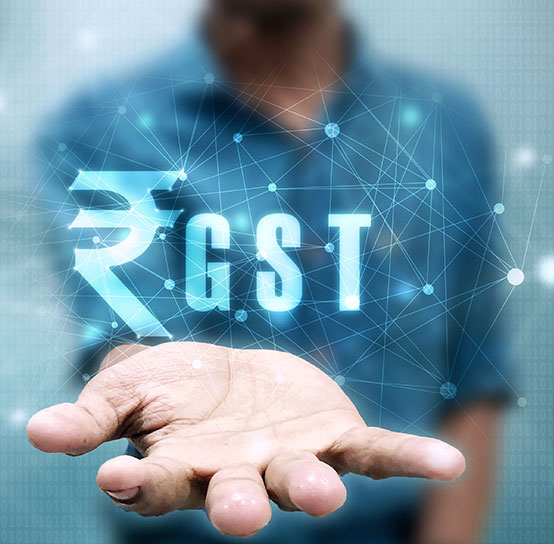-
Business Consulting
Our business consulting specialists offer a comprehensive blend of strategic advisory services. We assess the business, industry, operating model, synergy, skill sets and vision of the organisation and recommend the way forward
-
Digital Natives
Unlock growth with Grant Thornton Bharat's Digital Natives solutions. Customised support for tech-driven companies in healthcare, gaming, and more.
-
Digital Transformation Services
Grant Thornton’s digital transformation services help traditional businesses digitalise their business models with cloud technology, IoT consulting, app development and more DigiTech solutions.
-
Finance Transformation
Using a holistic approach, integrating digitalisation and digital transformation we help clients achieve transparency, control, governance, and faster decision making through real-time data within the business.
-
Human Capital Consulting
Our Human Capital Consulting team harnesses technology and industry expertise to assist in constructing adaptable organisations with transparency, fostering productive and value-driven workforces, and inspiring employees to engage meaningfully in their tasks.
-
Production Linked Incentive Scheme
Production-linked Incentive Scheme by the Indian government is aimed at boosting manufacturing. Grant Thornton Bharat offers varied services across sectors to help businesses avail of this scheme.
-
Public Sector Advisory
Our Public Sector Advisory team has focused streams, aligned with the core priorities of the Government of India. We are responsible for providing innovative and customized technical and managerial solutions.
-
Tech Advisory
We have amalgamated Digital Transformation, IT Advisory & Information Management and Analytics into a new offering, DigiTech.

-
Direct Tax services
Our tax specialists offer a comprehensive blend of tax services, tax litigation, regulatory and compliance services, helping you navigate through complex business matters.
-
Indirect Tax Services
Get tax services by leading tax firm Grant Thornton India. Our indirect tax services include consulting, compliance and litigation services for corporate, international and transaction tax
-
Transfer pricing services
Our transfer pricing services experts provide a range of services from provision of APA services to handling large global assignments including Country by Country reporting.
-
US Tax
At Grant Thornton, we help individuals and dynamic companies deal with US tax laws, which are one of the most complicated tax legislations across the world.
-
Financial Services - Tax
Best financial advisory services, tailored for small and large businesses by the experts having comprehensive knowledge of domestic laws and access to multifaceted tools to provide a valuable results.
-
Financial Reporting consulting services
Our experts have significant hands-on experience in providing IFRS/US GAAP services, end-to-end solutions and support services to fulfil financial reporting requirements.
-
Fund accounting and financial reporting
International operations often lack standardisation and have varied local reporting formats and requirements. Our experts can offer proactive insights, practical guidance, and positive progress and help meet regulatory timeframes.
-
Compliance and Secretarial Services
Our experts can assist in overhauling the entire compliance machinery of the organisation through evaluation of the applicable statutory obligations, monitoring of adequate governance controls, reporting and providing ongoing support.
-
Global People Solutions
As businesses transcend borders, both domestic and global considerations need equal attention. Our interim CFO and financial controller support services help organisations meet the business vision.
-
Finance and accounting outsourcing
Our accounting experts assist organisations in managing their accounting and reporting. Our dedicated Integrated Knowledge and Capability Centre (IKCC), allows us to service both the domestic and global markets efficiently and cost-effectively
-
Compliance Management System
We have automation solutions for you that will allow meeting government requirements and remain diligent, which when failed, can lead to penalties and loss in revenue.
-
Global compliance and reporting solutions
At Grant Thornton Bharat, we meet the challenges of our clients and help them unlock their potential for growth. Our professionals offer solutions tailored to meet our clients’ global accounting and statutory reporting requirements. With first-hand experience of local reporting requirements in more than 145+ locations worldwide, we provide seamless and consistent international service delivery through a single point of contact.
-
Related-party transaction governance
Related-party transactions (RPTs) are common in business structures where organisations engage with their group entities, such as holding companies, subsidiaries, associate concerns, joint ventures, or key management personnel, for various operational or financial purposes.
-
Family Offices & Private Client Services
Grant Thornton Bharat Private Client Services offers tailored advisory for family-owned businesses, focusing on governance, compliance, tax, succession planning, and family office structuring to sustain wealth and preserve legacies across generations.
-
GTMitra: Tax & Regulatory Tool
GTMitra, a specialised tax and regulatory tool by Grant Thornton Bharat, supports multinational businesses in understanding laws and regulations for effective growth strategies.
-
Labour codes
Labour codes solutions help you transition through the new legislation. At Grant Thornton, we help businesses divide their approach to make sure a smooth transition.
-
Alerts
At Grant Thornton India, with the help of our tax alerts, we help to provide updates on how to minimise your tax exposure and risks.
-
Unlocking opportunities: India investment roadmap
The India Investment Roadmap resource is designed to navigate the complexities of Indian tax and regulatory laws, providing seamless guidance and a comprehensive set of solutions to ensure a smooth process for investors aiming to establish or expand their presence in India.
-
CFO Solutions
Our comprehensive suite of solutions for CFOs

-
Cyber
In today’s time, businesses have gone through large transformation initiatives such as adoption of digital technologies, transition to cloud, use of advanced technologies et al.
-
Risk Optimisation
Our Governance, Risk and Operations (GRO) services encompass Internal Audit, Enterprise Risk Management, Internal Financial Controls, IT advisory, Standard Operating Procedures and other services.
-
Risk analytics
Grant Thornton Bharat’s CLEARR Insights is a state-of-the art data analytics platform that will help you in seamless data analysis and efficient decision-making.
-
Forensic & Investigation Services
The team of forensic advisory services experts consists of the best intelligence corporate experts, and fraud risk, computer forensic experts to deliver most effective solutions to dynamic Indian businesses.
-
Digital Forensics and Incident Response (DFIR)
Strengthen cyber resilience with proactive forensic audits
-
ESG consulting
Grant Thornton Bharat offers holistic ESG consulting solutions for sustainable business outcomes. With industry expertise and AI technology, we drive long-term value.

-
Transaction Tax Services
Our transaction tax experts understand your business, anticipate your needs and come up with robust tax solutions that help you achieve business objectives ensuring compliance and efficiency
-
Deal Advisory
Unlike other M&A advisory firm in India, we offer deal advisory services and work exclusively with controlled and well-designed strategies to help businesses grow, expand and create value.
-
Due Diligence
Grant Thornton’s financial due diligence services are aimed at corporate looking for mergers and acquisitions, private equity firms evaluating investments and businesses/promoters considering sale/divestment.
-
Valuations
As one of the leading valuation consultants in India, Grant Thornton specializes in all the aspects of the process like business valuation services, financial reporting, tax issues, etc.
-
Overseas Listing
Overseas listing presents a perfect platform for mid-sized Indian companies with global ambitions. Grant Thornton’s team of experts in listings, work closely with clients during all stages.
-
Debt & Special Situations Solutions
Grant Thornton Bharat offers specialist debt and special situations consulting services, including restructuring, insolvency, and asset tracing solutions.
-
Financial Reporting Advisory Services
Grant Thornton Bharat Financial Reporting Advisory Services offer end-to-end solutions for complex financial requirements, including GAAP conversions, IPO support, and hedge accounting advisory, ensuring accurate financial reporting and compliance.
-
Financial Statement Audit and Attestation Services
Grant Thornton Bharat offers customised financial statement audit and attestation services, ensuring impeccable quality and compliance with global standards. Our partner-led approach, technical expertise, and market credibility ensure effective solutions for your business needs.

- Agriculture
- Asset management
- Automotive and EV
- Banking
- Education and ed-tech
- Energy & Renewables
- Engineering & industrial products
- Fintech
- FMCG & consumer goods
- Food processing
- Gaming
- Healthcare
- Urban infrastructure
- Insurance
- Media
- Medical devices
- Metals & Mining
- NBFC
- Pharma, bio tech & life sciences
- Real estate and REITs
- Retail & E-commerce
- Specialty chemicals
- Sports
- Technology
- Telecom
- Tourism & hospitality
-
 Thought leadership Co-lending in India: Expanding credit access for MSMEsIn today’s rapidly evolving financial landscape, co-lending has emerged as a key enabler of credit expansion in India, facilitating partnerships between banks and non-banking financial companies (NBFCs) to extend credit more efficiently to underserved segments.
Thought leadership Co-lending in India: Expanding credit access for MSMEsIn today’s rapidly evolving financial landscape, co-lending has emerged as a key enabler of credit expansion in India, facilitating partnerships between banks and non-banking financial companies (NBFCs) to extend credit more efficiently to underserved segments. -
 Article Why India’s financial inclusion journey needs to focus on equity and access to creditFinancial services have expanded over a decade, giving millions access to bank accounts and digital payments. But true empowerment needs to reach every corner of the country if growth is to be long-term and sustained
Article Why India’s financial inclusion journey needs to focus on equity and access to creditFinancial services have expanded over a decade, giving millions access to bank accounts and digital payments. But true empowerment needs to reach every corner of the country if growth is to be long-term and sustained -
 Thought Leadership Competitive and sustainable agriculture & food processing in KeralaThe economy of Kerala is primarily driven by the services sector, which contributes 66% to the Gross State Domestic Product (GSDP).
Thought Leadership Competitive and sustainable agriculture & food processing in KeralaThe economy of Kerala is primarily driven by the services sector, which contributes 66% to the Gross State Domestic Product (GSDP). -
 Article Economic Survey 2024-25: Deregulation, investment and innovation for a Viksit BharatIndia's economic growth remains for a steady trajectory with real GDP expected to grow at 6.4% in FY25 and in the range of 6.3%-6.8% in FY26, reflecting resilience despite global uncertainties.
Article Economic Survey 2024-25: Deregulation, investment and innovation for a Viksit BharatIndia's economic growth remains for a steady trajectory with real GDP expected to grow at 6.4% in FY25 and in the range of 6.3%-6.8% in FY26, reflecting resilience despite global uncertainties.
-
Quarterly Aviation Insights
Explore the latest trends in aviation industry with Grant Thornton Bharat’s Quarterly Aviation Insights. Stay updated on industry growth, market shifts & key developments.

-
Freight Forward: Quarterly insights
Logistics sector in India is adapting to rising costs, global disruptions, and the growing urgency of sustainability.
-
India-UK
India-UK

The Government of India envisioned to transform India into a digitally empowered and a knowledge economy. With this aim, a flagship programme 'Digital India' was launched to boost digitization in the country. DigitalIndia initiative focuses on laying down the digital foundation, enhance the digital reach and contribute to the overall experience of the stakeholders. It is quite clear that this initiative has helped develop the ecosystem ofe-commerce in India.
Increased connectivity through internet across the country is one of the key factors for increased demand of online goods/ services. According to a report by Grant Thornton "Sector flash: E-commerce market in India – April 2021", market size of e-commerce in India is expected to reach USD 188 billion by 2025. While the sector provides additional opportunities for the sellers, tech-based companies and startups, there are associated compliance obligations as well under the Goods and Services Tax ('GST') and Income Tax which one should take note of.
Coverage of e-commerce transactions under the GST
Under the GST, there are specific provisions for e-commerce transactions. This includes definition of electronic commerce, e-commerce operator ('ECO'), registration requirements and filing of separate returns.
GST Act defines, "e-commerce" as "the supply of goods or services or both, including digital products over digital or electronic network".
"Electronic commerce operator" has been defined to mean "any person who owns, operates or manages digital or electronic facility or platform for electronic commerce".
Broadly speaking, there are two types of e-commerce business models:
- Marketplace based model
- Inventory based model
Marketplace based model:
In the marketplace based model, the suppliers list their products/ services on the platform provided by ECO and customer purchases the same from the platform by paying the consideration to ECO. Here, the ECO acts as a facilitator/ intermediary between the supplier and the customer.
Under this model, an additional responsibility has been cast on the ECO under the GST, requiring it to collect tax at source ('TCS') at the rate of 1% (0.5% CGST + 0.5% SGST or 1% IGST) from the sellers where consideration is to be collected by the ECO.
Further, the GST Act mandates the requirement of registration for every ECO who is required to collect TCS and for all the suppliers who supply goods and services through said ECO. An exemption from mandatory registration has been provided to supplier of services if aggregate turnover is not exceeding an amount of INR20 lakhs in a financial year (INR 10 lakhs in case of special category states).
The GST Council in its 47th meeting, held on 28 and 29 June 2022, recommended to extend exemption to the supplier of goods making intra-State supply through ECO if the aggregate turnover on all India basis does not exceed the threshold limit under section 22 of the CGST Act.
Currently, composition scheme is not available to the suppliers who are undertaking supplies through an ECO.As a welcome step, it has been recommended that suppliers under composition scheme would be allowed to make intra-State supplies through ECO.
Inventory based model:
In the inventory based model, suppliers undertake transactions directly with the customers through its own digital or electronic network/ platform. Such suppliers shall be squarely covered under the definition of ECObut provisions of mandatory registration and TCS shall not be applicable to them.
Apart from above-mentioned provisions, there is a separate mechanism for payment of tax with respect to certain notified services as per section 9(5) of the CGST Act. Same has been discussed in the succeeding paragraphs.
Treatment of certain notified services rendered through ECO
As mentioned above, few services have been specifically notified under the GST law for which ECO is liable to pay GST instead of supplier of such services. Primary intention of the exchequer is to shift the tax liability to tap under reporting of transactions by small service providers providing following notified services ('specified services'):
- Transportation of passengers in any radio-taxi, motor cab, maxicab and motor cycle, omnibus or any other motor vehicle
- Accommodation services in any hotels, guest houses, etc. from an unregistered supplier,
- Housekeeping services from an unregistered supplier, and
- Supply of restaurant services other than services supplied at specified premises.
Note: Specified premises means premises providing hotel accommodation service having declared tariff of any unit of accommodation above seven thousand five hundred rupees per unit (Rs 7500/- per unit) per day or equivalent.
Considering that diverse provisions are available for e-commerce transactions under GST, applicability of keyprovisions with respect to e-commerce transactions have been summarised below:
Coverage of e-commerce transactions under the Income Tax
Considering the fast paced growth of e-commerce market in India, the policy makers, to widen and deepen the tax base, introduced section 194O under the Income Tax Act, 1961 ('the Act') to bring participants of e-commerce transactions within the tax net.
Section 194O inter alia provides for deduction of tax (TDS) at the rate of 1% of the gross amount of sales or services or both by the ECO, who has facilitated the sale through its digital or electronic facility or platform.The tax has to be deducted by the ECO at the time of payment or credit (on amount of sales or services or both)to the e-commerce participant (resident supplier of goods or services), whichever is earlier.
Tax is required to be deducted under section 194O by ECO even where the amount for sale of goods or services has been directly paid by the purchaser of goods / receiver of services to the e-commerce participant.
It should also be noted that where tax has been deducted under section 194O on a transaction, no tax isrequired to be deducted under any other provision of withholding tax.
Applicability of section 194O can be explained through the following example:
Every INR 100 sale by seller through the digital platform of ECO would require a tax deduction of INR 1 (1% ofINR 100) under section 194O of the Act. As mentioned above, the withholding is required irrespective of the fact that whether the amount for sale of goods or services or both from the customer is received by ECOdirectly or not.
Exemption from applicability of section 194O:
Obligation to deduct tax under section 194O shall not apply where e-commerce participant:
- is an individual or HUF;
- has furnished PAN or Aadhaar card to ECO; and
- gross amount of sales or services or both during the year does not exceed INR 5 lacs;
Further, exemption has been provided to ECO from deducting tax where ECO is inter alia engaged in hosting advertisements on its digital or electronic platform.
Certain important clarifications issued by CBDT for applicability of section 194O:
- If a transaction falls under the purview of section 194O, 194Q and 206C(1H) [TDS and TCS on sale of goodsrespectively], section 194O shall supersede other sections and tax will be deducted under section 194O only.
- Section 194O shall not apply in relation to e-auction activities carried out by e-auctioneers subject to satisfaction of certain specified conditions.
- In respect of a payment gateway facilitator, section 194O shall not apply where tax has been deducted by the e-commerce operator under this section.
- There will be no obligation to deduct tax by an insurance agent or insurance aggregator under section 194O in years subsequent to the first year, where they have no involvement in transaction between insurance company and buyer of insurance policy.
[Definition of 'e-commerce' and 'electronic commerce operator' are pari materia under both GST and IncomeTax regime. However, section 194O of the Act additionally defines 'e-commerce operator' as "a person resident in India selling goods or providing services or both, including digital products, through digital or electronic facility or platform for electronic commerce."]
Marketplace based model:
Under marketplace based model, the ECO who has provided the electronic or digital platform to the e-commerce participant (supplier) shall be required to deduct tax under section 194O at the rate of 1% in respectof sale of goods or services or both to the customers.
Inventory based model:
Under the inventory based model, since the suppliers undertake transactions with the customers through their own digital or electronic network/platform, it could be said that the ECO and supplier are the same person and not distinct persons. Accordingly, it could be said that no tax is required to be deducted under section 194O in this scenario.
In the said scenario, section 194Q may come into play. Section 194Q of the Act casts an obligation on the buyer of goods to deduct tax at source on making payment to a resident seller at the rate of 0.1% in case where value of such goods exceeds INR 50 lacs (exclusive of GST). Moreover, tax is to be deducted only by the buyer whose total sales or turnover from the business carried on by him exceeds INR 10 crores during the immediately preceding FY. It should be noted that TDS of 0.1% shall apply on amount exceeding INR 50 Lakhs. Thus, incase of inventory based model, section 194Q may apply in cases which cross the prescribed threshold for the seller and the buyer.
Certain important clarifications issued by CBDT for applicability of section 194Q:
- Where GST component is indicated separately in the invoice and tax is deducted at the time of credit of the amount in the account of the seller, then tax shall be deducted under section 194Q on the amount credited without including such GST.
However, incase tax is deducted on payment basis because payment is earlier than credit, tax would be deducted under section 194Q on the whole amount as it is not possible to identify the GST component of the amount to be invoiced in future. - In a situation where there is a purchase return and tax has already been deducted under section 194Q, it is clarified that tax deducted under the said section may be adjusted against the next purchase against the same seller provided the money is refunded against the purchase return.
However, no adjustment shall be allowed where the purchase return is replaced by the goods by the seller as in that case purchase on which tax was deducted under the said section has been completed with goods replaced. - Section 194Q shall not apply to a non-resident buyer whose purchase of goods from seller resident in India is not effectively connected with the Permanent Establishment of such non-resident in India.
Key points for consideration-GST
- Introduction of consolidated form for ECO:
In the model of e-commerce, the sellers are usually located in different states. Accordingly,registration by ECO needs to be applied in all the states in which the suppliers are located and accordingly GSTR-8 is required to be filed for all such states. Government can explore the possibilities of subsuming the compliance for all the states in a single form, through some technological enhancements on the portal, so that desired reporting for all the states can be done by filing one form only. - Reducing compliance for low value items:
As per the existing provisions of GST law, ECO has to collect TCS irrespective of any threshold benefit for each individual supply and ECO is also required to pay GST in case of specified services.In order to undertake said compliances, ECO must have all the details of its suppliers and buyers.This requires significant investment in terms of time and resources by ECO. In this regard, exemption can be provided to ECO from the TCS compliance and payment of GST with respect to low-value items supplied through it.
Currently, GST law expects ECO to undertake major compliances to ensure that fair tax revenue is being collected on timely basis. Due to these multiple compliances, odds are tilted in favor of large ECO with financial muscle. Since digital commerce is transforming the trade globally, certain relaxations can be looked upon by the government for ECO and flexibility in terms of shifting the compliance obligations back to the original suppliers can be shown.
Income Tax
- Scope of the term "gross amount" under section 194O
The term 'gross amount' under section 194O should ideally be defined to end uncertainty about the amount on which withholding tax is to be calculated. It should be clarified that whether the said amount would be the total invoice value including shipping, handling and other charges but excluding GST/ other taxes. - Applicability of section 194O to non-resident e-commerce operators
It is worthwhile to note that the definition of e-commerce participant specifies that the person to whom payment is being made should be 'resident in India' but the definition of e-commerce operator is silent on this aspect. It does not mention whether the e-commerce operator should be a 'resident in India' or not for applicability of section 194O. Thus, the pertinent question arises as to what is the scope of Section 194O of the Act, i.e. whether it is applicable only to resident e-commerce operators or to non-resident e-commerce operators as well? In this regard, a clarification from the CBDT would be most welcome.
Conclusion
Though, the Government of India is making consistent efforts towards ease of doing business in India, a clear and simple approach should further help the exponentially growing e-commerce sector. Few reasonable steps aligned with above recommendations may ease the compliances for e-commerce transactions. Further, this will automatically result in leveraging the initiative of 'Digital India' and upshoting the digital trade.
(With inputs from Pranav Aggarwal, Manager at Grant Thornton Bharat LLP)
This article was originally published on Taxman.
Submit a request for a proposal to explore how our services can help you and your company.


